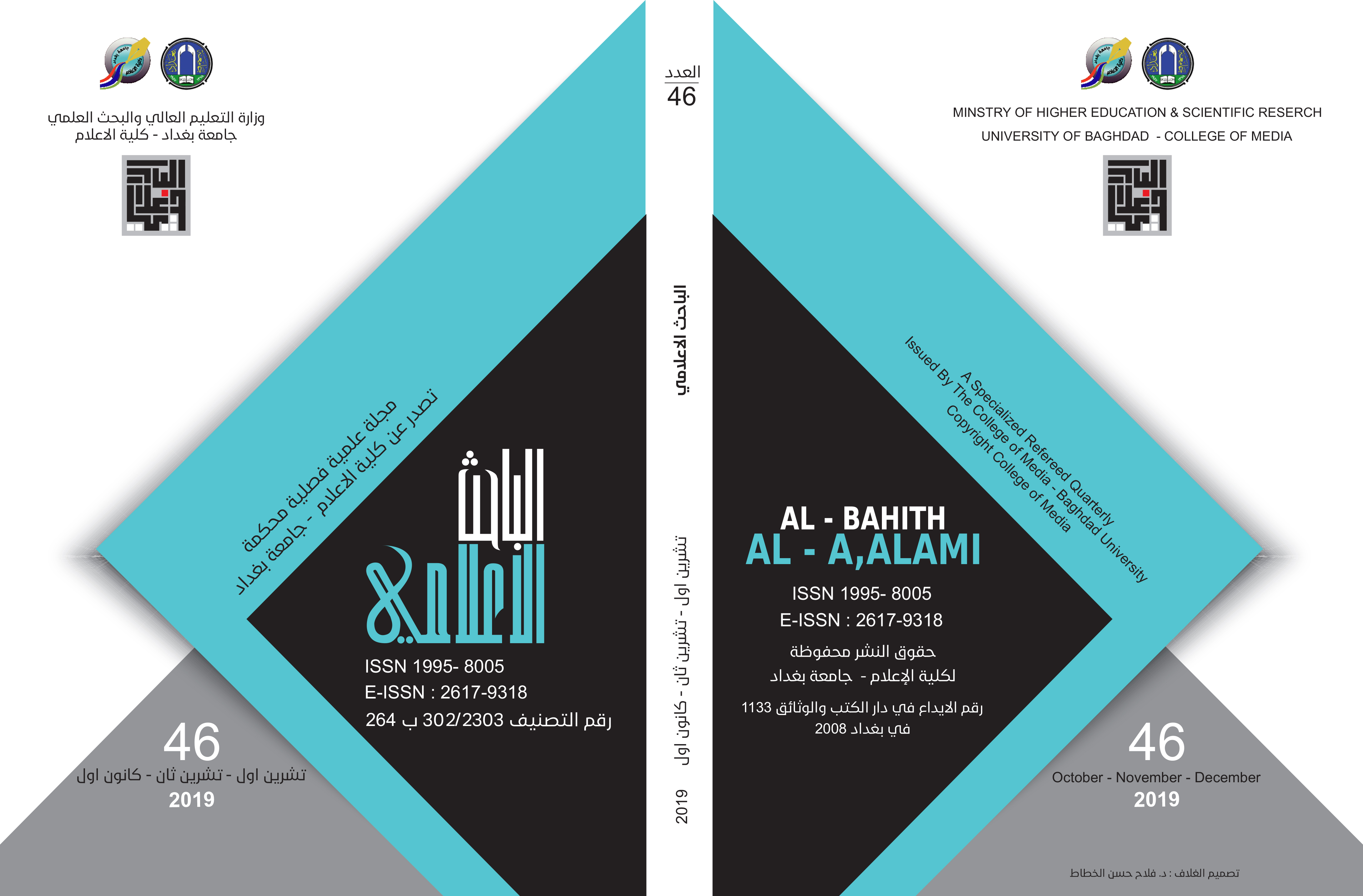THE ISSUES OF YOUTH IN THE TALK SHOWS IN THE IRAQI SATELLITE CHANNELS:
(An Analytical Study of the Shabab wa Banat Program at Al-Sumaria TV Channel and of the Hala Shabab at Al-Iraqia TV Channel) (A Research Drawn from a Master’s Thesis)
DOI:
https://doi.org/10.33282/abaa.v11i46.412Keywords:
: Issues of Youth; Talk Shows; Iraqi Satellite Channels.Abstract
The purpose of this research is to identify the youth issues in Talk Shows in the Iraqi satellite channels via monitoring a sample of episodes of the Talk Shows episodes which are concerned and analyzed the youth issues in the Iraqi satellite channels, namely, «Hala Shabab Program» at Al-Iraqia satellite Channel and «Shabab wa Banat Program» at Al-Sumaria satellite Channel by recording and re-watching them again. This research is classified as one of descriptive researches. The survey method was adopted in this study.
For this purpose, the researcher prepared an analysis form. The researcher designed the content analysis form based on the research problem, goals and questions related to the research problem, which included the categories of analysis that were presented to the experts, relying on calculating the number of occurrences and percentages as a statistical measure. The researcher reached a number of results, the most important of which are:
- The most prominent issues, that are displayed on «Hala Shabab» and «Shabab wa Banat» Programs, are focused on the artistry and cultural issues which are ranked firstly, and social issues are ranked secondly.
- The programs of the research’s sample are focused on (male) gender, according to the nature of the guests’ gender, via a large percentage (87.5%) for the program of «Hala Shabab», and (76.47%) for the «Shabab wa Banat» These percentages are indicated that the two programs are focused on the dialogue with male guests more than the female guests whose percentages of hosting, in the research sample programs, are very poor.
- The majority of programs’ guests, «Hala Shabab», «Shabab wa Banat», are respectively introduced the three high ranks (poet, civil activist and artist) for each. Such category of people reflects the concentration of this kind of program that hosts guests of these qualities in.
- The programs of the research’s sample are also different in the methods of presentation of dialogue issues largely and variously, namely the program of «Hala Shabab» is based on the category of (one dialogue issue) which is presented a large percentage (90%). Whilst, the program of «Shabab wa Banat» is focused on the category (more than one dialogue issue) which is inevitably presented high percentage (95%). Thus, there are variations and differences in the methods of issues presentation in the programs of the research’s sample.
The most prominent issues, that are displayed on Hala Shabab and Shabab wa Banat Programs, are focused on the artistry and cultural issues which are ranked firstly, and social issues are ranked secondly.
The programs of the research’s sample are focused on (male) gender, according to the nature of the guests’ gender, via a large percentage (87.5%) for the program of Hala Shabab, and (76.47%) for the Shabab wa Banat program. These percentages are indicated that the two programs are focused on the dialogue with male guests more than the female guests whose percentages of hosting, in the research sample programs, are very poor.
The majority of programs’ guests, Hala Shabab, Shabab wa Banat, are respectively introduced the three high ranks (poet, civil activist and artist) for each, which are reflected that these programs are concentrated, on these qualities, in hosting guests.
The programs of the research’s sample are also different in the methods of presentation of dialogue issues largely and variously, namely the program of Hala Shabab is based on the category of (one dialogue issue) which is presented a large percentage (90%). Whilst, The program of Shabab wa Banat is focused on the category (more than one dialogue issue) which is inevitably presented high percentage (95%). Thus, there are variations and differences in the methods of issues presentation in the programs of the research’s sample.
Downloads
References
ابن منظور. (1988). لسان العرب، الجزء الثاني . بيروت: دار لسان العرب .
اسماعيل محمود حسن. (2011). مناهج البحث الاعلامي . القاهرة: دار الفكر العربي.
رافي حمدي الحديثي. (2004). واقع البرامج الحوارية في قناة العراقية الفضائية: رسالة ماجستير غير منشورة. بغداد، جامعة بغداد: كلية الاعلام.
روبرت ايل هيلارد. (2008). الكتابة للتلفزيون والاذاعة ووسائل الاعلام الحديثة. (مؤيد حسن فوزي، المترجمون) غزة: دار الكتاب الجامعي.
شيماء ذو الفقار زغيب. (2009). مناهج البحث والاستخدامات الاحصائية في الدراسات الاعلامية. القاهرة: الدار المصرية اللبنانية.
طعيمه رشدي احمد. (2004). تحليل المحتوى في العلوم الانسانية: مفهومه-اسسه-استخداماته . القاهرة: دار الفكر العربي.
عادل عبد الرزاق، و صفد حسام الدين. (2014). التلفزيون وتوعية الشباب الجامعي بتحديات الهوية الثقافية في العراق . مجلة الباحث الاعلامي(26).
عبد العزيز بركات. (2012). مناهج البحث الاعلامي. القاهرة: دار الكتاب الحديث.
عبد الكريم فهد الساري. (2012). تكنيك الحديث والمقابلات الصحفية. عمان: دار اسامة للنشر والتوزيع.
عبد الله احمد اليوسف. (2013). الشباب والثقافة المعاصرة رؤية قرانية في معالجة التحدي الثقافي (الإصدار ط2). بيروت: منشورات ضفاف.
علي عبد الامير الكعبي. (2016). دراسات في سكان العراق. بيروت: الساقي للطباعة والنشر.
لمياء سليماني. (2015). قضايا الراي العام في البرامج التلفزيونية الحوارية: (رسالة ماجستير غير منشورة). الجزائر، جامعة محمد خيضر، بسكرة: كلية العلوم الانسانية.
محسن جلوب الكناني. (2012). تقنيات الحوار الاعلامي . عمان: دار اسامة للنشر والتوزيع .
محمد الفاتح حمدي. (2012). استخدام الشباب الجزائري لوسائل الاتصال والاعلام الحديثة وانعكاسها على قيمهم الثقافية والاجتماعية . مجلة المستقبل العربي(398).
مصطفى حميد كاظم الطائي. (2011). الاعلام والتنمية البشرية: دراسة في النظريات والتجارب التنمية العالمية . الشارقة: الافاق المشرقة ناشرون.
مصطفى يوسف كافي. (2015). هندسة الحوار والاقناع. عمان: دار الحامد للنشر والتوزيع.
نسمة احمد البطريق، و عادل عبد الغفار. (2005). الكتابة للإذاعة والتلفزيون. القاهرة: مركز جامعة القاهرة للتعليم المفتوح.
هادي احمد العيثاوي. (2018). محاضرات في الصحافة الاذاعية والتلفزيونية. بغداد: دار الكتب والوثائق.
هدى مالك شبيب. (2012). التسويق في البرامج التلفزيونية الحوارية . الاستاذ(201 ).
1 - Zuayeb, Shaima Zulfikar, Methods of research and statistical uses in media studies, Cairo, the Egyptian Lebanese House, 2009, p. 109.
2-Abdul Aziz, Barakat, Methods of Media Research, Cairo, Dar al-Kitab al-Hadith, 2012, p. 257.
3-Ismail, Mahmoud Hassan, Media Research Methods, Cairo, Dar Al-Fikr Al-Arabi, 2011, p. 218.
4. Ta›imah, Roshdy Ahmed, Analysis of Content in Human Sciences - Concept - Foundations - Uses, Cairo, Dar Al-Fikr Al Arabi, 2004, p. 70.
5 - Ibn Manzoor, the tongue of the Arabs, Part II, Beirut, Dar Sanan Arabs, 1988, p 480.
6 - Abdul Razzaq, Adel, Hossam, Safad, TV and raising the awareness of youth university challenges of cultural identity in Iraq, Journal of Media Researcher, No. 26, 2014, p. 127.
7-Al-Taei, Mustafa Hameed Kazem, Media and Human Development, A Study in theories and Experiences Development, Global, Sharjah, Prospects Publishers, 2011, p. 196.
8-Madkour, Ibrahim Bayoumi, Dictionary of Social Sciences, Egypt, Egyptian General Book Press, 1975, p. 333.
9-Hamdi, Mohamed El-Fateh, The Use of Algerian Youth for Modern Media and Reflections on their Cultural and Social Values, Al-Mustaqbal Al-Arabi Magazine, Beirut, Center for Arab Unity Studies, No. 398, p.
10-Al-Yousef, Abdullah Ahmed, Youth and Contemporary Culture: A Qur›anic Vision in Addressing the Cultural Challenge, Beirut, 2, Dafaf Publications, 2013, p. 19.
11. Al-Kaabi, Ali Abdul-Amir, Studies in the Population of Iraq, Beirut, Saki Press, 2016, p. 159.
12-Kafi, Mustafa Youssef, Engineering Dialogue and Persuasion, Amman, Dar Al-Hamed Publishing and Distribution, 2015, p.
13-Hadithi, Rafi Hamdi, The Reality of Talks in Iraqi Satellite TV, Unpublished Master Thesis, University of Baghdad, College of Information, 2004, p. 22.
14-Shabib, Huda Malik, Marketing in the talk show, Professor, No. 201, 2012, p.
15-Kanani, Mohsen Glob, Techniques of Media Dialogue, Amman, Dar Osama Publishing and Distribution, 2012, p. 84.
16. Abdel-Azim, Reem Ahmed, Media Dialogue Training Program for Skills Development, former source, p. 47
17-Sulaimani, Lamia, Issues of Public Opinion in Dialogue Television Programs, Unpublished Master Thesis, Mohammed Khaydar-Biskra University, Faculty of Humanities, Algiers, 2015, p.
18 - Mohsen Glob Kanani, ibid., P. 84.
19-Abdul Karim Fahad Al-Sari, Technic Hadith and Press Interviews, Amman, Dar Osama Publishing and Distribution, 2012, p. 33.
20. Robert E. Hillard, Writing for Television, Radio and Modern Media, former source, p. 266.
21-Penguin, Nesma Ahmed and Abdel Ghaffar, Adel, Writing for Radio and Television, Cairo, Cairo University Center for Open Education, 2005, p. 44.
22-Al-Ithawi, Hadi Ahmed, Lectures in Radio and Television Journalism, Baghdad, House of Books and Documents, 2018, p
Downloads
Key Dates
Published
Issue
Section
License
Copyright (c) 2019 outhor

This work is licensed under a Creative Commons Attribution 4.0 International License.
Authors retain copyright and grant the journal right of first publication with the work simultaneously licensed under a Creative Commons Attribution License (CC BY 4.0) that allows sharing the work with recognition of authorship and initial publication in ABBA journal.


















